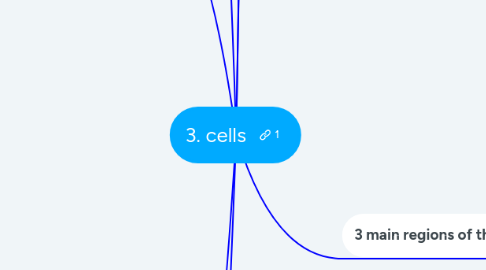
1. Basic unit of life
2. cell theory
2.1. the basic structural and functional unit of life
2.2. All organisms are made from one or more cells
2.3. Cells may arise only from other cells
2.3.1. except for the first cell
3. 3 main regions of the cell
3.1. Plasma membrane
3.1.1. a selectively permeable outer barrier
3.1.1.1. Passive transport
3.1.1.1.1. simple diffusion
3.1.1.1.2. facilitated diffusion
3.1.1.1.3. osmosis
3.1.1.2. Active transport
3.1.1.2.1. directly or indirectly uses ATP to get things across the membrane
3.1.1.2.2. 2 types
3.1.1.3. Vesicular transport
3.1.1.3.1. Endocytosis
3.1.1.3.2. exocytosis
3.1.2. composition
3.1.2.1. Lipid bilayer
3.1.2.1.1. phospholipids
3.1.2.1.2. glycolipids
3.1.2.1.3. cholesterol
3.1.2.2. proteins
3.1.2.2.1. integral
3.1.2.2.2. peripheral
3.1.2.3. glycocalyx
3.1.2.3.1. fuzzy, sticky, carbohydrate-rich area at a cell’s surface that acts as a biological marker allowing cells to identify each other
3.1.2.3.2. Cell Adhesion Molecules (CAMs)
3.1.3. Cell junctions
3.1.3.1. connections between cells
3.1.3.2. 3 types
3.1.3.2.1. Tight junctions
3.1.3.2.2. Desmosomes
3.1.3.2.3. Gap junctions
3.1.4. extentions
3.1.4.1. cilia
3.1.4.1.1. whip-like, motile cellular extensions on the exposed surfaces of some cells
3.1.4.1.2. flagella
3.1.4.1.3. Centrioles, called basal bodies, form the bases
3.1.4.1.4. Movement of dynein arms associated with the microtubules of the cilium produces the propulsive power stroke, and the recovery stroke that characterizes ciliary movement
3.1.4.2. microvilli
3.1.4.2.1. finger-like extensions of the plasma membrane that increase surface area
3.2. the cytoplasm
3.2.1. cellular material between the cell membrane and the nucleus,
3.2.2. 3 parts
3.2.2.1. organelles
3.2.2.1.1. Membrane Bound
3.2.2.1.2. Non-Membranous
3.2.2.2. intracellular fluid/cytosol
3.2.2.3. inclusions
3.2.2.3.1. insoluble molecules
3.2.2.3.2. glycogen
3.2.2.3.3. granules
3.2.2.3.4. pigments
3.2.2.3.5. lipid droplets
3.2.2.3.6. crystals
3.3. the nucleus
3.3.1. the organelle that controls cellular activity
3.3.2. genetic material
3.3.3. double-membrane barrier surrounding the nucleus, enclosing the fluid and solutes of the nucleus.
3.3.4. consists of
3.3.4.1. nuclear envelope
3.3.4.1.1. outer membrane of the nuclear envelope is continuous with the rough ER
3.3.4.1.2. inner membrane is lined with a shape-maintaining network of protein filaments
3.3.4.2. nucleolus
3.3.4.2.1. dark-staining spherical bodies within the nucleus
3.3.4.2.2. the sites of assembly of ribosomal subunits
3.3.4.3. chromatin
3.3.4.3.1. fundamental unit
3.3.4.3.2. composition
4. Extracellular material
4.1. stuff outside the plasma membrane
4.2. extracellular fluid
4.2.1. interstitial fluid
4.2.2. blood plasma
4.2.3. cerebrospinal fluid
4.3. Cellular secretions
4.3.1. lubricating fluids
4.4. Extracelluar matrix
4.4.1. proteins and polysaccharides that self-assemble into an organized mesh that helps bind body cells together
5. Cell cycle AKA Mitosis
5.1. Interphase
5.1.1. cell is doing its job
5.1.2. period between cell formation and cell division
5.1.3. 3 sub phases
5.1.3.1. G1
5.1.3.1.1. the cell is synthesizing proteins and actively growing
5.1.3.2. S Phase
5.1.3.2.1. DNA is replicated
5.1.3.3. G2
5.1.3.3.1. enzymes and other proteins are synthesized and distributed throughout the cell
5.2. cell division
5.2.1. process necessary for growth and tissue repair
5.2.2. 2 main events during
5.2.2.1. Mitosis
5.2.2.1.1. 4 phases of nuclear division
5.2.2.2. Cytokinesis
5.2.3. Control
5.2.3.1. surface-volume relationships
5.2.3.2. chemical signaling
5.2.3.3. contact inhibition
6. Apoptosis
6.1. the programmed cell death of stressed, unneeded, injured, or aged cells
6.2. steps
6.2.1. The mitochondrial membrane becomes permeable
6.2.2. Cytochrome c and other factors leak into the cytosol, activating intracellular caspase enzymes
6.2.3. Caspases set off intracellular digestive activity, initiating apoptosis
6.2.4. The dying cell shrinks, but retains its contents
6.2.5. The cell releases signals that draw phagocytotic macrophages
7. cellular development
7.1. Embryonic cells
7.1.1. cells are exposed to different chemical signals that cause them to follow different pathways in development
7.1.2. Cell differentiation is the process of cells developing specific and distinctive features
7.1.3. Chemical signals influence development by switching genes on and off
7.2. rates of cell death and division
7.2.1. Most organ systems are well-formed and functional before birth
7.2.2. the body continues to form new cells throughout childhood and adolescence
7.3. Cell aging
7.3.1. wear and tear theory of aging
7.3.1.1. considers the cumulative effect of slight chemical damage and the production of free radicals
7.3.2. mitochondrial theory of aging
7.3.2.1. suggests that free radical damage to mitochondria reduce the ability of the cell to produce energy for cellular processes
7.3.3. immune theory of cell aging
7.3.3.1. states that aging is a result of progressive weakening of the immune system, reducing the ability of the body to fight off pathogens and heal systemic inflammation.
7.3.4. genetic theory of cell aging
7.3.4.1. suggests that cessation of mitosis and cell aging are genetically programmed, resulting from the progressive shortening of the telomeres of the cell

